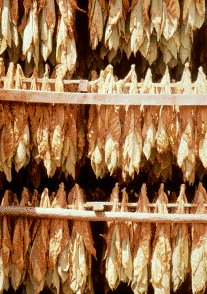 |  |
| Nicotine | The tobacco plant |
Nicotine is the drug found in tobacco which vaporises into smoke when tobacco leaves are burnt. In its pure form it is a rapid acting, extremely toxic drug, that has often been used as an agricultural insecticide. Indeed, there have been reports of gardeners who have died from handling nicotine, and their death from respiratory failure occurred within a few minutes.
 |  |
| Nicotine | The tobacco plant |
The action of nicotine in the body is very complicated. It is a mild stimulant which has an effect upon the heart and brain. It stimulates the central nervous system causing irregular heartbeat and blood pressure, induces vomiting and diarrhea, and first stimulates, then inhibits glandular secretions. Despite this, smokers often say they use cigarettes to reduce stress and anxiety and claim their use has a calming effect. Cigarette smoking was encouraged for just this reason by the governments on both sides amongst soldiers in the First and Second World Wars. Nicotine seems to provide both a stimulant and a depressant effect, and it is likely that the effect it has at any time is determined by the mood of the user, the environment and the circumstances of use. Studies have suggested that low doses have a depressant effect, whilst higher doses have stimulant effect.
Nicotine is a highly addictive drug, but with repeated use, tolerance develops rapidly. For example, non-smokers can absorb only about 4 mg of nicotine before symptoms of nausea, vomiting, diarrhea and weakness begin. But a smoker may tolerate twice as much nicotine as a nonsmoker without any noticeable effects. The smoke from one cigarette may contain upto 6 mg of nicotine (1/7 of the lethal dose by ingestion!), but only about 0.2 mg is absorbed into the body.

| Tobacco leaves drying and curing |
Many varieties of tobacco plant contain more than 10% of active ingredients, called nicotinia alkaloids. These are based on a pyridine ring, with a side group. Pyridine is an unpleasant-smelling liquid present in coal tar. Depending on the particular alkaloid, the sidegroup can change. In nicotine itself, this sidegroup is a pyrrole, which is a 5-membered ring containing a nitrogen atom. Pyrrole rings are very important in biology, as they form the basis of the heme group in such vital molecules as chlorophyll and hemoglobin. Nicotine is the most important and well known of these alkaloids, and is found in the chief tobacco plant, Nicotinia tabacum.
 |  |
| Pyridine | Pyrrole |
Nicotine can be oxidised to nicotinic acid (niacin) which is present in minute amounts in all living cells. The corresponding amide, niacinamide, is an essential B vitamin.
 |  |
| Nicotinic Acid (Niacin) | Niacinamide |